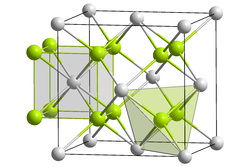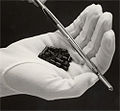Uranium (IV) oxide
| Crystal structure | ||||||||||||||||
|---|---|---|---|---|---|---|---|---|---|---|---|---|---|---|---|---|

|
||||||||||||||||
| __ U 4+ __ O 2− | ||||||||||||||||
| Crystal system | ||||||||||||||||
| Space group |
Fm 3 m (No. 225) |
|||||||||||||||
| Lattice parameters |
a = 547 pm |
|||||||||||||||
| Coordination numbers |
U [8], O [4] |
|||||||||||||||
| General | ||||||||||||||||
| Surname | Uranium (IV) oxide | |||||||||||||||
| other names |
Uranium dioxide |
|||||||||||||||
| Ratio formula | UO 2 | |||||||||||||||
| Brief description |
brown to black, crystalline powder |
|||||||||||||||
| External identifiers / databases | ||||||||||||||||
|
||||||||||||||||
| properties | ||||||||||||||||
| Molar mass | 270.03 g mol −1 | |||||||||||||||
| Physical state |
firmly |
|||||||||||||||
| density |
10.97 g cm −3 |
|||||||||||||||
| Melting point |
2865 ° C |
|||||||||||||||
| solubility |
almost insoluble in water |
|||||||||||||||
| Hazard and safety information | ||||||||||||||||
 Radioactive |
||||||||||||||||
|
||||||||||||||||
| As far as possible and customary, SI units are used. Unless otherwise noted, the data given apply to standard conditions . | ||||||||||||||||
Uranium (IV) oxide (often also uranium dioxide , UO 2 ) is an oxide of uranium . In nature it occurs e.g. B. before as uraninite, the uraninite originally consisting of uranium (IV) oxide is partially further oxidized to uranium (VI) oxide.
presentation
By reducing uranium (VI) oxide with hydrogen , uranium (IV) oxide is formed.
The uranium (IV) oxide required for the manufacture of fuel elements in nuclear power plants is mainly made from uranium (VI) fluoride . There are several methods of conversion. Wet chemical processes are the AUC and ADU processes.
When AUC method ( A mmonium U ranyl C method arbonat) is with the aid of water , ammonia and carbon dioxide ammonium uranyl carbonate formed and this is then converted by heating to uranium (VI) oxide. This is then reduced to uranium (IV) oxide with hydrogen.
With the ADU method ( A mmonium D i U Ranat method) of UF 6 to hydrolysis to uranyl fluoride precipitation with ammonia solution to ammonium diuranate and subsequent calcination produced in a hydrogen stream uranium (IV) oxide. The equations for the ADC process are:
The ADU process is also well suited for the recovery of uranium from solutions with uranium (VI) compounds.
In addition to these methods, a dry method, the DC powder method , is also used. In this process, the hexafluoride is converted directly to uranium (IV) oxide at higher temperatures. The advantage here is that there are no waste solutions with uranium content that require further processing. The equation for this procedure is:
Another method for producing uranium (IV) oxide is the PUREX process used for the reprocessing of fuel elements . During extraction, uranyl nitrate is formed, which in turn is converted into uranium (VI) oxide by heating and then reduced to uranium (IV) oxide.
properties
Physical Properties
Uranium (IV) oxide is a brown to black, crystalline powder. It has a cubic crystal system , the space group Fm 3 m (no. 225) , with a lattice parameter a = 547 pm and four formula units per unit cell . The structure type is the CaF 2 type ( fluorite ) and the coordination numbers are U [8], O [4].
Uranium (IV) oxide is also a semiconductor . In laboratory tests, a functional Schottky diode could be produced from UO 2 . Because of problems due to ionizing radiation and doping , this material is not used in electronic circuit technology.
Freshly produced uranium (IV) oxide from earthly natural uranium has a specific activity of 22300 Bq / g.
Chemical properties
Uranium (IV) oxide-air mixtures (dust clouds) are explosive; as a fine powder, it reacts violently with the air, releasing heat ( pyrophoric ). It burns to triurane octoxide U 3 O 8 .
Applications
Uranium (IV) oxide is the most important nuclear fuel in nuclear reactors . It is processed into so-called “ pellets ” to be used in fuel rods .
Furthermore, uranium (IV) oxide was previously used as a coloring additive in various glasses and ceramics. In the form of a URDOX resistor with thermistor properties , it was used to limit the current in heating circuits of all-current devices .
Individual evidence
- ↑ a b c d e Entry on uranium dioxide in the GESTIS substance database of the IFA , accessed on February 16, 2017(JavaScript required) .
- ↑ Not explicitly listed in Regulation (EC) No. 1272/2008 (CLP) , but with the specified labeling it falls under the group entry uranium compounds with the exception of those specified elsewhere in this Annex in the Classification and Labeling Inventory of the European Chemicals Agency (ECHA) , accessed on February 1, 2016. Manufacturers or distributors can expand the harmonized classification and labeling .
- ↑ The hazards emanating from radioactivity do not belong to the properties to be classified according to the GHS labeling.
- ^ M. Volkmer: Basic knowledge about nuclear energy , Hamburgische Elektricitäts-Werke-AG, 1996, p. 76; ISBN 3-925986-09-X .
- ↑ Extraction of uranium from solutions. - Document DE3587334T2 .
- ↑ Process for the production of a nuclear fuel sintered body - Document DE10115015C1 .
- ^ Norman N. Greenwood, Alan Earnshaw: Chemistry of the elements , 1st edition, VCH Verlagsgesellschaft, Weinheim 1988, p. 1616; ISBN 3-527-26169-9 .
- ↑ Yong Q. An, Antoinette J. Taylor, Steven D. Conradson, Stuart A. Trugman, Tomasz Durakiewicz, and George Rodriguez: Ultrafast Hopping Dynamics of 5 f Electrons in the Mott Insulator UO 2 Studied by Femtosecond Pump-Probe Spectroscopy . In: Phys. Rev. Lett. . 107, No. 20, 2011, pp. 207402-207405. doi : 10.1103 / PhysRevLett.106.207402 .
- ^ Thomas Meek: Semiconductive Properties of Uranium Oxides. (PDF; 88 kB) (No longer available online.) Materials Science Engineering Department, University of Tennessee, 2000, archived from the original on September 1, 2012 ; Retrieved July 18, 2013 . Info: The archive link was inserted automatically and has not yet been checked. Please check the original and archive link according to the instructions and then remove this notice.
literature
- Ingmar Grenthe, Janusz Drożdżynński, Takeo Fujino, Edgar C. Buck, Thomas E. Albrecht-Schmitt, Stephen F. Wolf: Uranium , in: Lester R. Morss, Norman M. Edelstein, Jean Fuger (eds.): The Chemistry of the Actinide and Transactinide Elements , Springer, Dordrecht 2006; ISBN 1-4020-3555-1 , pp. 253-698; doi : 10.1007 / 1-4020-3598-5_5 .










